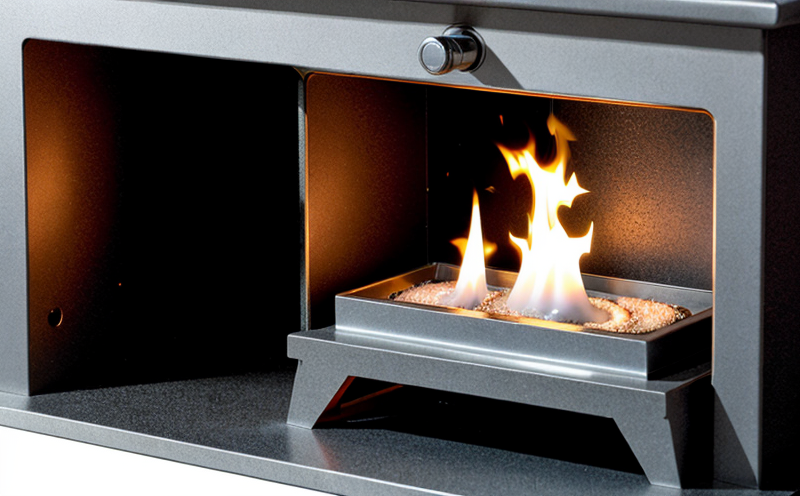Flame Spread and Ignition Resistance Testing of Flooring Materials
In fire safety testing, the evaluation of flooring materials’ flame spread and ignition resistance is critical to ensuring public safety. This assessment helps determine how quickly a material will ignite under controlled conditions and assess its potential for contributing to fire propagation. This service ensures that manufacturers comply with stringent fire safety regulations, helping them meet industry standards such as ISO 6947, ASTM E84, and EN 13501-1.
The testing process involves the use of specialized equipment and methodologies designed to simulate real-world conditions. The specimen preparation is crucial; it includes ensuring that the flooring material is cut into standard dimensions, typically 254 mm x 254 mm (10 in x 10 in), with a thickness ranging between 6.35 mm and 9.525 mm (0.25 in to 0.375 in). The specimens are then placed on a standardized support assembly within the test chamber.
The test apparatus used for this service includes an oxygen index tester, which measures the percentage of oxygen required to support combustion. This data is essential as it indicates how easily the material can be ignited and its resistance to flame spread. Another key instrument is the cone calorimeter, which determines heat release rate (HRR), smoke production, and other parameters that influence fire behavior.
The testing procedure involves subjecting the specimen to a series of standardized conditions designed to replicate real-world scenarios. The specimens are exposed to an ignition source for a specific duration, during which time their flame spread is measured using a phototransistor sensor or similar device. The results are then compared against predetermined acceptance criteria based on industry standards.
The importance of this testing cannot be overstated in sectors like construction and building materials where fire safety compliance is mandatory. By conducting these tests, manufacturers can ensure that their products meet the necessary standards and regulations, thereby protecting lives and property from potential hazards.
Scope and Methodology
| Parameter | Description |
|---|---|
| Specimen Preparation | The specimens are cut to standard dimensions and thicknesses, ensuring uniformity across all samples. |
| Testing Conditions | Standardized conditions replicate real-world scenarios for accurate testing. |
| Instruments Used | Instruments include an oxygen index tester and a cone calorimeter, among others. |
| Data Collection | Data on flame spread, heat release rate, smoke production, etc., is collected during the test. |
- The specimens are subjected to controlled ignition sources for a defined duration.
- Flame spread and other parameters are continuously monitored using specialized sensors.
- Data is analyzed against industry standards such as ISO 6947, ASTM E84, and EN 13501-1.
Customer Impact and Satisfaction
The results of flame spread and ignition resistance testing play a vital role in enhancing customer satisfaction. By ensuring that flooring materials meet the necessary standards, customers can rest assured that their buildings are safe from potential fire hazards. This service not only aids in compliance with regulations but also provides valuable insights into product performance.
Customers benefit significantly by knowing that the products they source or manufacture have been rigorously tested and meet stringent safety criteria. This testing process helps to mitigate risks associated with material flammability, contributing to safer environments for occupants. It also ensures that manufacturers can confidently market their products as safe and reliable.
Furthermore, this service supports sustainable practices by helping companies identify materials that are both fire-safe and environmentally friendly. By selecting the right flooring materials, customers contribute to reducing overall environmental impact while maintaining high levels of safety.
Environmental and Sustainability Contributions
The testing of flooring materials for flame spread and ignition resistance also contributes positively to environmental sustainability. By identifying products that meet stringent fire safety standards, manufacturers can reduce the likelihood of fires, which in turn minimizes waste generation and associated environmental impacts.
Moreover, this service helps promote the use of sustainable materials that are not only fire-resistant but also environmentally friendly. Manufacturers can leverage these tests to select and develop products that contribute to greener building practices without compromising safety. This dual focus on both fire safety and sustainability fosters a more responsible approach to product development and manufacturing.
By ensuring compliance with international standards such as ISO 6947, ASTM E84, and EN 13501-1, this service plays a crucial role in promoting safer and more sustainable building materials. This holistic approach supports the global movement towards more resilient and environmentally conscious construction practices.





